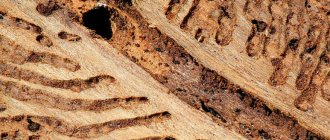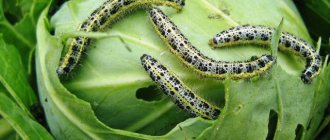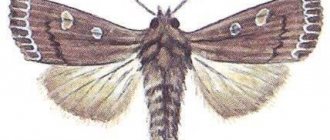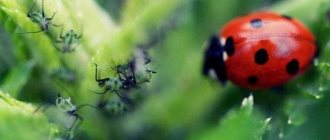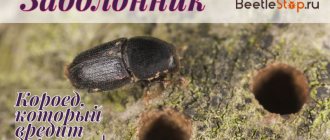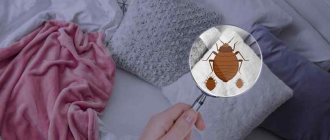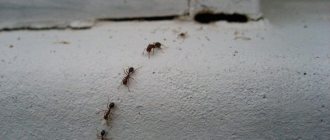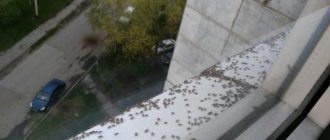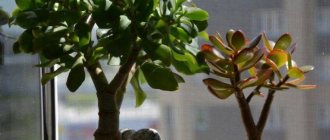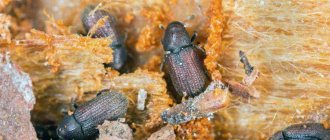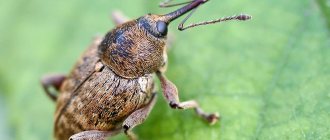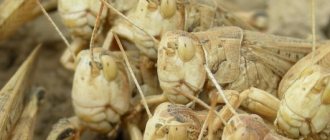Bark beetle infestation poses a great danger to an orchard. The apple tree in which the harmful larvae have settled is seriously injured. The beetle larvae gnaw through wood and sapwood, deprive the tree of juices, simultaneously infecting it with pathogenic fungi, and then mechanically destroy the trunk. An exhausted tree stops growing, loses its harvest, and if the pest is not neutralized in time, it eventually dies. Every gardener needs to know how to deal with bark beetle on apple and pear trees, and what preventive measures will help maintain a healthy garden.
Characteristics of the apple bark beetle
The bark beetle, or sapwood beetle, is an insect about 4 millimeters in size. The body of the beetle is cylindrical, dark brown in color. The elytra are covered with punctate grooves and stiff hairs. The paws and antennae are dark brown.
The bark beetle spends the main part of its life in the thickness of wood, which makes the pest difficult to detect. The emergence of insects occurs in the spring, at the end of the flowering of apple trees. At this time, the beetles mate and settle in new places, infecting fruit trees. The female bark beetle lays eggs under the bark of an apple or pear tree, gnawing holes for numerous ovipositions.
At the same time, the female bark beetle brings in the mycelium of the fungus Monilia Candida, which also begins to occupy the tree.
The eggs soon hatch into whitish larvae with powerful mandibles. They feed on the tissues and juices of the tree, leaving branched passages in the thickness of the wood. In the spring of next year, the larvae pupate, during the flowering of the apple trees they turn into mature beetles and fly out.
Diseased, weakened, shaded trees often become victims of the pest. Both adult and young plantings suffer. Pests such as bark beetles, codling moths, flower beetles and aphids can settle not only on apple and pear trees, but also on stone fruits - cherries, cherries, and plums.
Pests of fruit tree trunks. Tree trunk diseases
The following diseases of tree trunks and roots are distinguished: 1) mucilage. 2) thickening, 3) cancer, 4) rot of trunks and roots, 5) death of roots.
Slime leakage is characterized by the leakage of liquid from the trunks of old deciduous trees.
The cause of mucilage is wound damage to trees, frost cracks, bark cracks and others. To treat mucus in trees, it is recommended to cut out the damaged parts and then lubricate these places with coal tar; deep wounds are covered with special putties and cements.
Trunk thickening is a disease characterized by the formation of swellings of various shapes on tree trunks as a result of increased cell growth. The main causes of thickening are fungi, bacteria, mechanical damage and frost damage.
Thickening on cedar and Weymouth pine is caused by rust fungus and is accompanied by tarting. This mushroom is dioecious with a full development cycle. The aecidial stage of the fungus develops on the trunks and branches of these trees and has the appearance of orange bubbles. The mycelium spreads in the tissues of the cortex and causes cell proliferation, as a result of which the affected area thickens.
Control measures. Destruction at a distance of 180-250 m around Weymouth pine and cedar plantings of all types of currants and gooseberries that contribute to the spread of the fungus.
Trunk cancer. The disease is characterized by the formation of a deep wound on the trunk, surrounded by an influx. The cause of cancer in trees is frost damage (frost canker), various fungi (fungal canker), and mechanical damage.
The most dangerous is fungal cancer, caused in most cases by rust or marsupial fungi.
Cancer caused by the fungus occurs on larch and fir trunks. This mushroom belongs to the marsupial fungi, a group of discomycetes.
The development of the fungus in an infected trunk occurs as follows: the mycelium first develops in the phloem, partly intercellularly or in cells and sieve tubes, and kills the bark. Then the mycelium reaches the cambium and kills it, as a result of which the growth of wood in the affected area stops and the wood dies.
Control measures. Trimming dry branches on which this fungus grows as a saprophyte.
On Scots pine trunks, cancer is caused by fungi. The pine disease caused by these rust fungi is of the same nature. Infection occurs through branches, on which the fungus develops primarily and from where the mycelium passes into the trunk. Resin accumulates on the surface of the wound. Every year, the damage covers an increasing part of the trunk circumference and causes weakening of the tree's growth.
Cancer accompanied by tarting (seryanka) is often found on pine trunks. Seryanka is caused by various rust fungi.
Seryanka disease is widespread in pine plantations and is very dangerous for these plantations.
Control measures. Cleaning of trees infected with seryanka in case of mass infection of plantings. Trees must be removed gradually so as not to cause windfall.
Cancer of the trunks of fruit trees and maples is caused by a marsupial fungus.
The fruiting bodies of the fungus are dark red and granular. Infection of trees occurs through wounds in trunks and branches with conidia or ascospores. After the bark falls off, the wood is exposed, forming an open wound. An influx of growing healthy tissue forms around the wound. The tree dies when the wound rings the trunk. The source of infection is the fruiting bodies that form around the influx.
Control measures. Trimming branches infected with the fungus and cutting down heavily infected trees.
On the trunks of poplars and willows, cancer is caused by a marsupial fungus from the pyrenomycetes group.
The fruiting bodies are flat or lenticular, black. The fungus infects trees through wounds on trunks and through dead branches, and mainly affects weakened trees.
Control measures. Trimming infected branches and smearing cancerous tumors with carbolineum.
Signs of defeat
The first signs of a bark beetle attack are the appearance of wood flour and sawdust on the bark of a tree or near the trunk. The sawdust is pushed out by beetles and their larvae, gnawing out the wood of the fruit tree. When examining the bark, you may notice small holes from which dust spills out.
The color of the sawdust indicates the degree of damage to the tree:
- brown and brown sawdust shows that the bark beetle is gnawing on the bast - the outer membranes of the trunk;
- white sawdust is an indicator of deep damage to the trunk by the pest.
Associated signs of damage:
- Frequent visits to trees by woodpeckers. This bird usually feeds on pests that live inside the wood.
- Sudden drying of branches, wilting, stopping of shoots in growth.
- Holes in the bark about 2 millimeters in size and gum production are obvious symptoms of bark beetle activity.
- Peeling of the bark, exposure of wood, corroded by winding passages, is the last stage, which usually ends with the death of the tree.
Experienced gardeners believe that there is no point in treating a tree heavily damaged by bark beetles - it must be immediately destroyed.
Senezh-Insa - a bark beetle remedy with a stable effect
An example of an excellent antiseptic is SenezhInsa, also made in Russia. The drug has been actively used since 2012 and is in demand both among professional agronomists and amateur summer residents. The product is completely colorless, packaged in small canisters of 5 liters or large barrels of 60 kg.
The concentrate is based on water, so when interacting with wood, its texture and color do not change.
The drug penetrates the tree bark, leaving the active components there. Non-toxic and effective. Helps get rid of different types of beetles and bacteria, regardless of the stages of their development.
Summarizing all of the above, we note that it is not enough to know how to cure a tree from bark beetle when insect damage has reached such a level that it is almost impossible to save the plant. In order for the garden to grow healthy and fruitful, you need to monitor the trees, preventing the appearance of pests and treating the trunks at the initial stages of infection.
Treatment
Before you start fighting the bark beetle, you need to carefully examine the trees in your garden. If the trunks are worn out with holes from which white sawdust is falling, the bark is separated from the wood, and there are many winding passages underneath - you will have to say goodbye to the tree: cut it down and burn it. This link will tell you what to do if mice have chewed the bark of an apple tree.
If the holes in the bark are sporadic and the wood flour is brown in color (the infection is shallow), you can still try to save the tree.
Spraying
A common practice for combating bark beetles is to spray trees after the trees have finished flowering, during the insect flight period. To carry out the procedure you must have:
- large, reliable sprayer (sprayers with a telescopic rod are convenient);
- workwear, gloves;
- a respirator to protect the respiratory tract from poisons (preferably gas-dust-proof models);
- mask or safety glasses.
The working solution of the drug is generously applied to the trunks and branches of apple, pear and other trees. Repeated treatment with insecticide is carried out after two weeks.
Remember safety precautions when processing the garden! Use medications only in the recommended dosage according to the instructions.
Insecticides
The drugs used to protect trees are systemic insecticides that can accumulate in plant tissues:
"Arrivo". The advantages of the drug are high efficiency and long-lasting action. The disadvantage is that the solution is toxic to pollinating insects and humans.
"Bitoxibacillin." Effective against adults and larvae, but does not affect eggs. The drug requires repeated treatments. Safe for bees and humans, does not accumulate in fruits.
"Calypso". The drug is fast-acting and produces a noticeable effect within a few hours. The action of the product is prolonged. Disadvantage: toxicity.
"Confidor Extra". A long-lasting product that is resistant to elevated temperatures and rinsing. Effective against pests at any stage. Low toxicity to humans and animals (hazard class III), but toxic to beneficial microorganisms (do not allow it to enter the soil). "Confidor Extra" is also used for stem injections into the tree.
"BI-58". An organophosphate preparation that acts in the intestines of the bark beetle. Low danger to humans (III hazard class). Disadvantage: the drug is toxic to bees.
Traps and repellers
A common method of garden protection is bark beetle traps and baits. In the spring, the branches cut down during pruning are laid out in piles away from the trees. The beetles are attracted by the smell of cut wood and flock to the bait to lay eggs. After the end of the beetles' summer (3-4 weeks), the branches are burned.
Mechanical collection of pests is carried out during their reproduction period - within 2-3 weeks after the apple trees bloom. Carefully inspect the trunks of apple trees and destroy any collected pests. Read here what to do if hares gnaw on an apple tree.
For private farmsteads, a more effective way to combat the bark beetle may be the use of antipheromones that repel the pest.
Antipheromone repellers are special tapes and tablets that emit an odor unpleasant to insects. They are safe for animals and humans. Antipheromone tablets are not sold in stores; they are used by specialist phytopathologists, and each type of beetle uses its own “aromatic” composition. The cost of such garden treatment is very high.
Pheromone traps cannot be used in a private garden - they will attract beetles from all over the area. They are used in large forestry enterprises to concentrate pests in a specific area and then destroy it.
Syringing
Using the injection method, you can save a tree at the beginning of beetle infestation - in the presence of brown sawdust and single flight holes, when the bark is not separated from the stem. Exterminators make injections into the tree trunk using professional devices.
Injection technique at home:
- A concentrated solution of the drug is prepared.
- The solution is poured into a volumetric syringe, then injected into the passages of the beetles.
- The holes are sealed with garden pitch.
The drugs used are Confidor, Chlorophos, Antizhuk, Karbofos, Tanrek, Calypso. The same insecticides must be sprayed on the apple tree and neighboring trees. After two weeks, the insecticide treatment is repeated.
Boosting immunity
Since the pest chooses weakened and oppressed trees, strengthening the immunity of fruit trees is an important task for the gardener in the fight against the beetle.
- Avoid unnecessary injury to the tree.
- Seal fresh cuts and tree fellings with garden varnish so as not to attract pests. This material will tell you how to cover the saw cut on an apple tree.
- Feed apple and pear trees in a timely manner. In hot and dry weather, trees must be provided with watering.
- Do not allow weeds to multiply, cultivate the soil in tree trunk circles.
Step-by-step plan-instructions for fighting bark beetles in the garden
In order not to subsequently look for ways to get rid of the bark beetle in the garden, you need to follow simple rules when you first discover it:
- Treatment of purchased seedlings with insecticides before planting. Lepidocid and Btoxibacillin are suitable.
- Trim the dried parts of the plant in a timely manner, collect, and burn the remains.
- Regularly loosen and dig up the soil around the tree trunk.
- After abundant flowering is completed, spray the garden with preparations that protect against bark beetle infestation. These products include “Aktara”, “Confidor”, “Sherpa”. It is necessary to carefully treat the entire crown with the preparation.
- Use repellers based on antipheromones to prevent the development of a colony of parasites in the garden.
- If you find holes on the trunks formed by the vital activity of woodworms, inject special preparations to combat them using a syringe. This procedure must be carried out several times, covering the hole with garden pitch.
- On garden areas exceeding 11 hectares, it is advisable to use pheromone traps. This method allows you to attract adult individuals to a limited area and destroy them. The use of traps in small areas threatens the loss of all plantings.
Preventing the bark beetle from settling in the garden is easier than fighting it, especially with larvae and pupae. The passages of woodworms disrupt the metabolic processes of trees, which leads to their death. Timely inspection and care of the garden will protect the trees from the bark beetle settling in them.
Scheme of treatment and prevention with drugs
It is recommended to use the following scheme of preventive treatment with insecticides:
1. Immediately after flowering, apple trees are sprayed with systemic preparations (Confidor, Antizhuk, Arrivo and others).
2. Repeated treatment is carried out after 2 weeks.
You can independently prepare a protective solution of laundry soap with carbolic acid . Green soap (2 cups) and the same amount of carbolic acid are dissolved in a 5-liter container. The mixture is diluted with water to a volume of 20 liters.
The resulting liquid is sprayed onto apple and pear trees.
Reasons for appearance
A week after flowering, apple bark beetles fly out to mate and build nests. During this period, the males first become active, select a suitable tree, and gnaw a tunnel in it.
Then they lure females with secreted pheromones. Fertilized beetles expand the network of tunnels under the bark and lay about 100 eggs at the end of each branch.
Such a process in the depth of the apple tree is possible only for one reason - weakened immunity of the plant. Pests can easily gnaw through the top layer of the tree and settle in its thickness. Depleted and diseased apple trees are attacked.
Preventive measures
The main measure to prevent bark beetle is to keep the orchard clean and well-groomed:
- regular inspection of fruit trees;
- timely autumn pruning;
- burning pruned branches;
- removal of plant residues and weeds in the garden.
To protect against beetles in the spring, trunks and skeletal branches are coated with lime-clay mash (a mixture of clay and manure with the addition of slaked lime). This article will tell you about whitewashing an apple tree in the spring.
During the pest's summer, beetle baits - freshly cut branches and stumps - are laid out in piles away from the trees. No later than after 3 weeks - a month, the wood trimmings must be burned. Read about pruning old apple trees here.
Danger of infection
Fruit sapwood is attracted by the smell of freshly cut wood. They gather in places where there are branches and stumps that have not been removed from the garden. Fresh cuts and wounds on the surface of apple trees and other fruit plants are also at risk.
Infestation with bark beetles has the following negative consequences:
- damage to the tree's power supply system;
- disruption of the circulation of juices due to passages gnawed by the larvae;
- introduction of fungal infections by females into the thickness of apple trees, which soon begin to progress;
- death of the tree.
conclusions
- The fight against bark beetles is quite complex and requires the use of comprehensive measures: sanitary and hygienic care of plantings, strengthening the immunity of apple and pear trees, and preventive spring treatments with systemic drugs.
- A tree that has recently been infected can still be saved by injecting the beetle burrows with insecticides. Unfortunately, trees heavily damaged by bark beetle cannot be saved - they must be destroyed by burning.
- By following preventive measures, you can prevent your garden from becoming infected. Even little things are important for this: not leaving open cuts on trees, protectively coating the trunks with a clay-lime mixture, timely removal of diseased and dried branches. Every gardener is obliged to protect his garden from the insidious invasion of bark beetles.
We help develop immunity in the culture
The best and most effective way to protect trees is to develop immunity in them. It is important to understand that a healthy crop will have strong wood, due to which the bark beetle will avoid such a crop. After all, he is looking for a tree with soft wood, in which it is easier for him to survive and lay his own offspring.
And to boost and strengthen your immune system, use tools such as:
- use the preparation nb 10, the granules of which are scattered around the tree and then watered with water;
- gum 30;
- phosphorus and potassium agents.
All these substances can strengthen the immune system of the apple crop and make it unstable to external negative factors.
